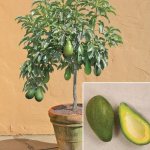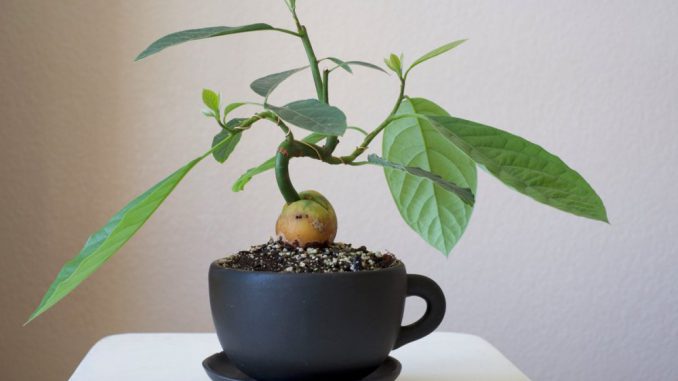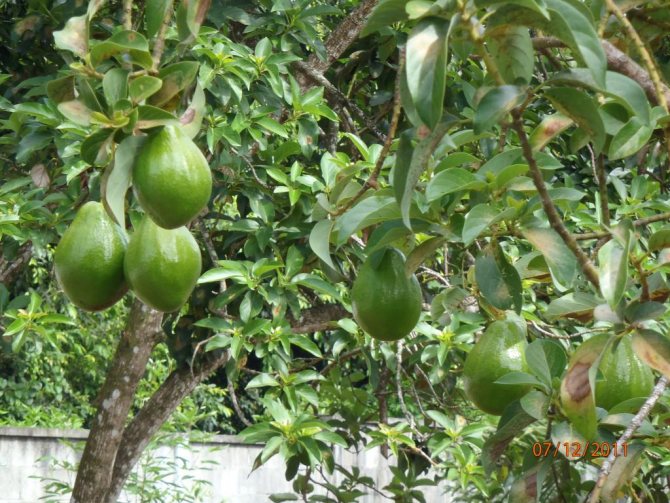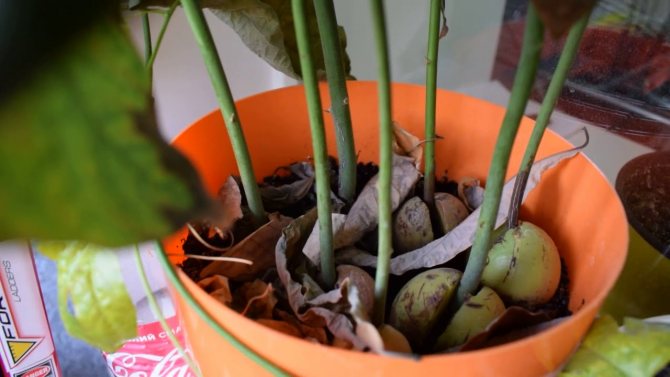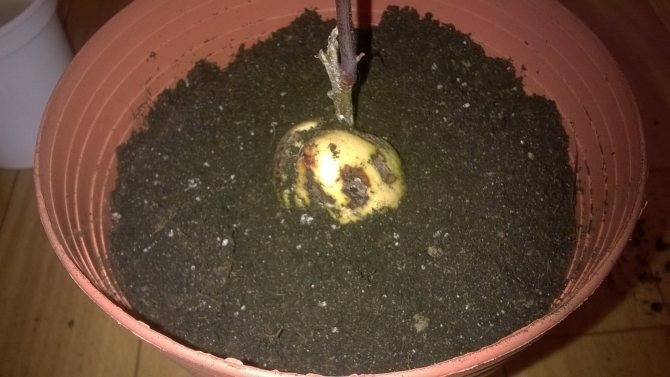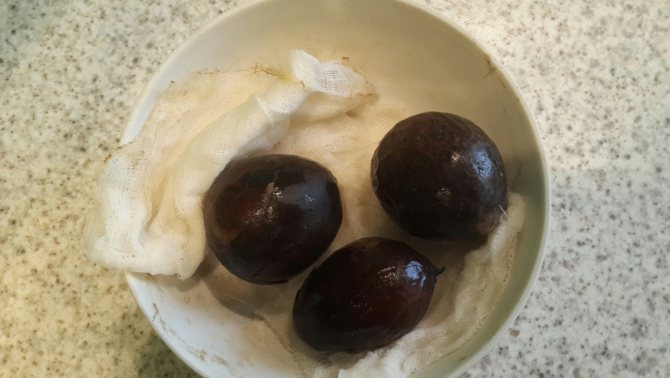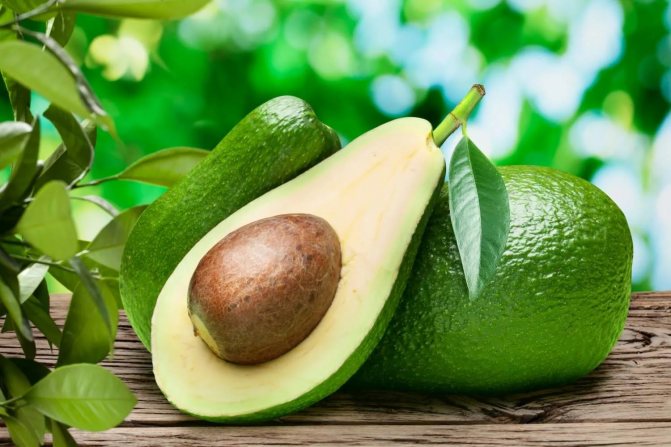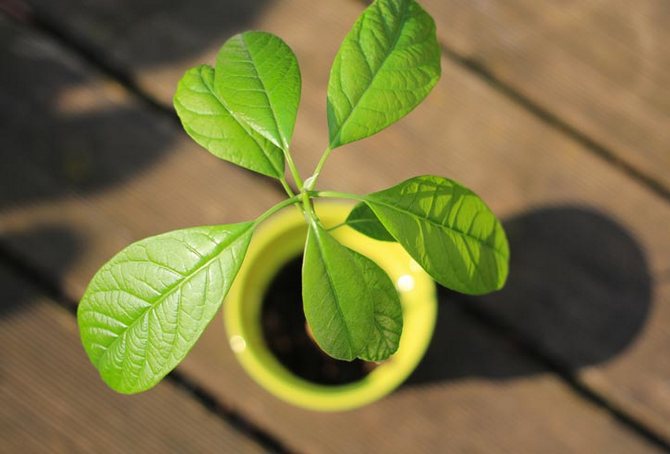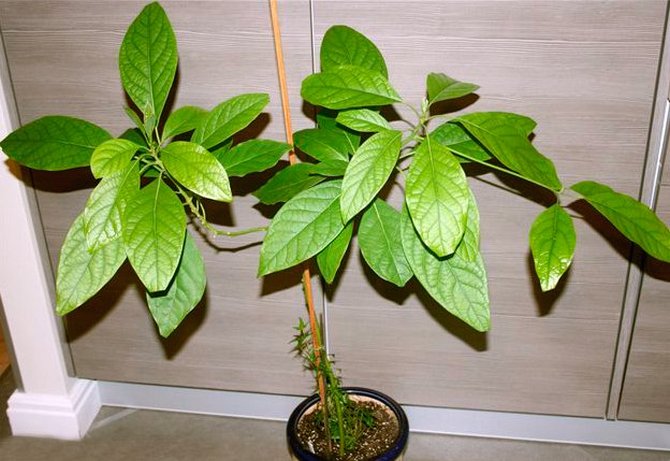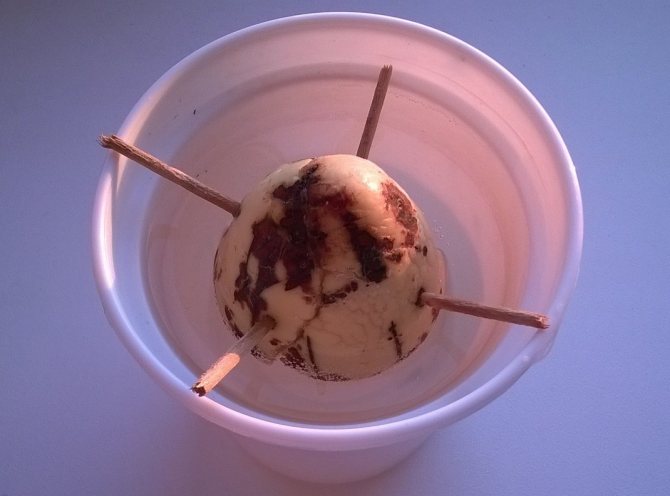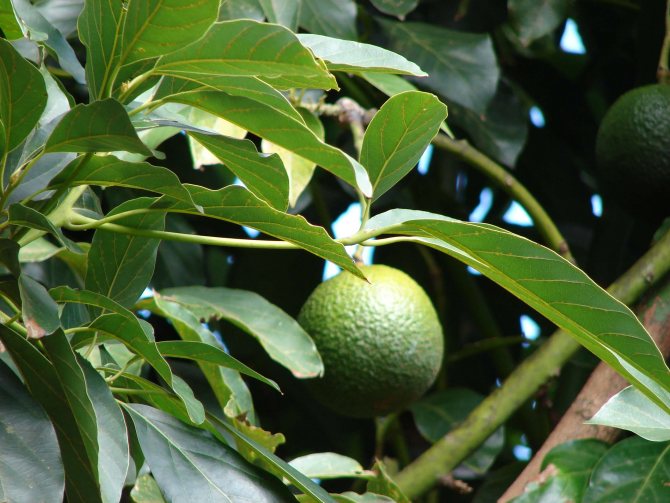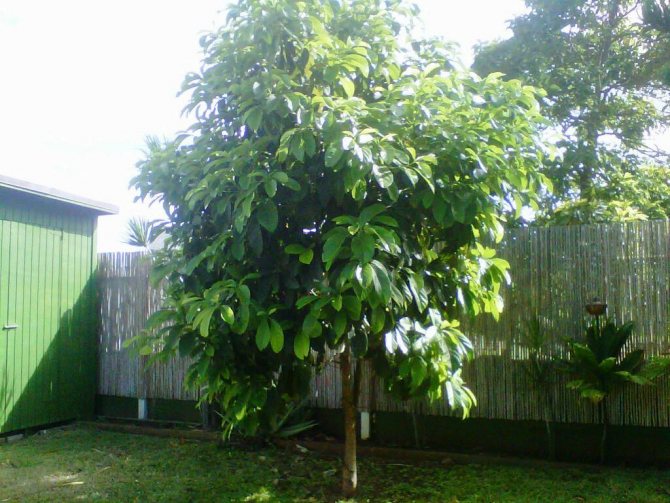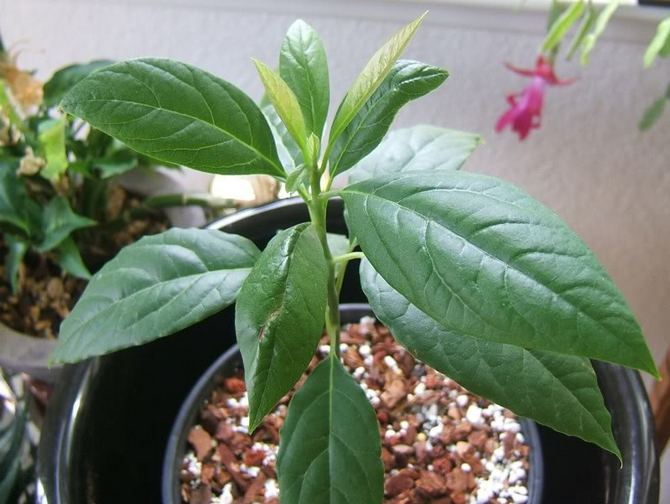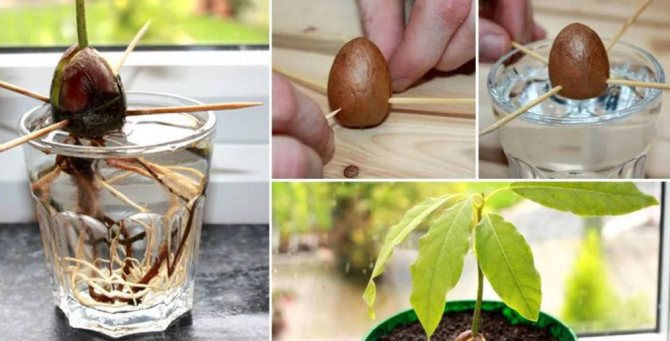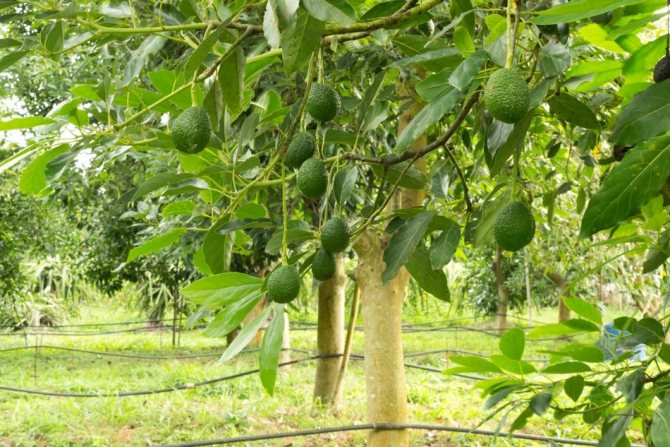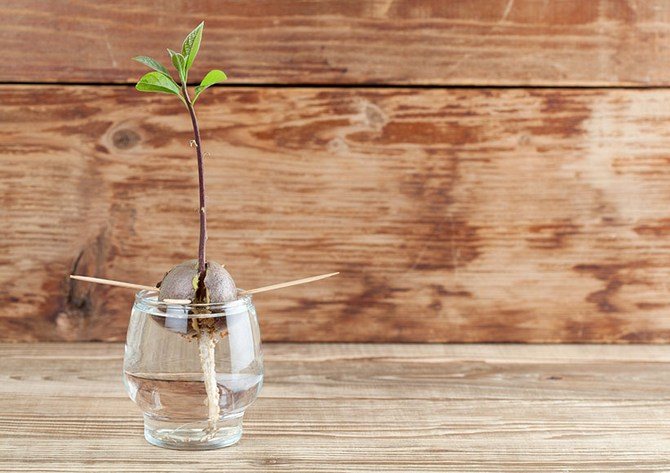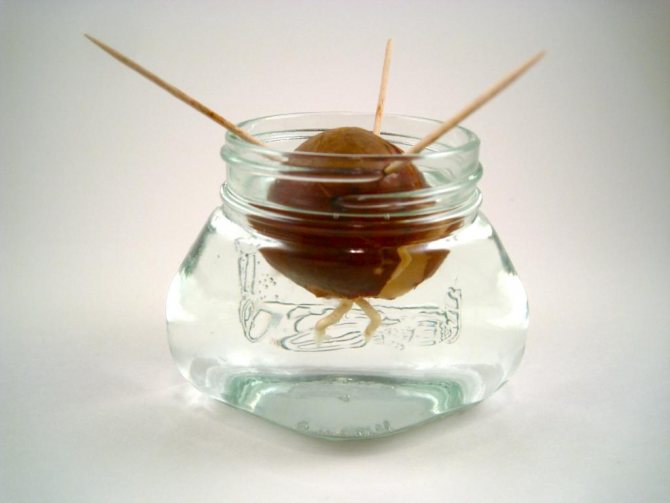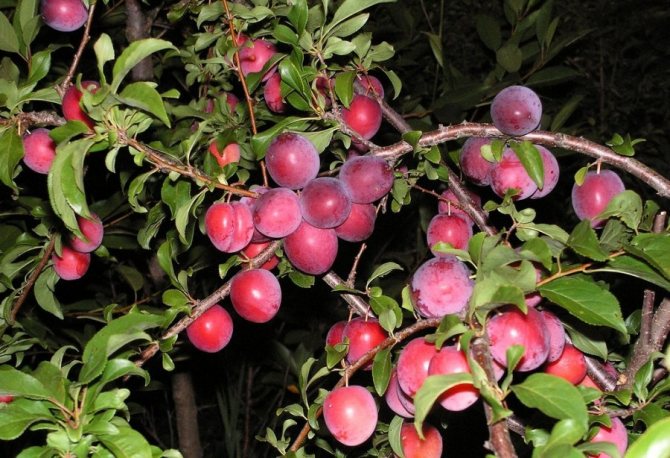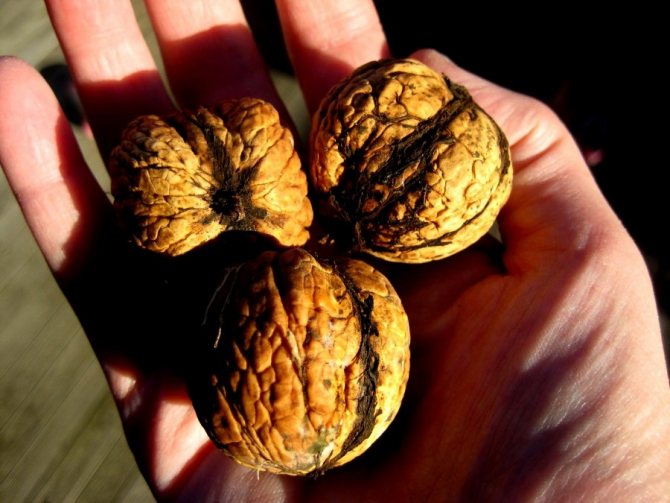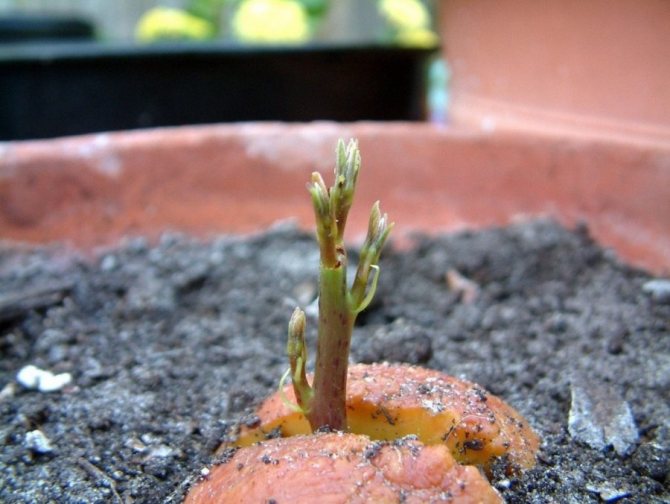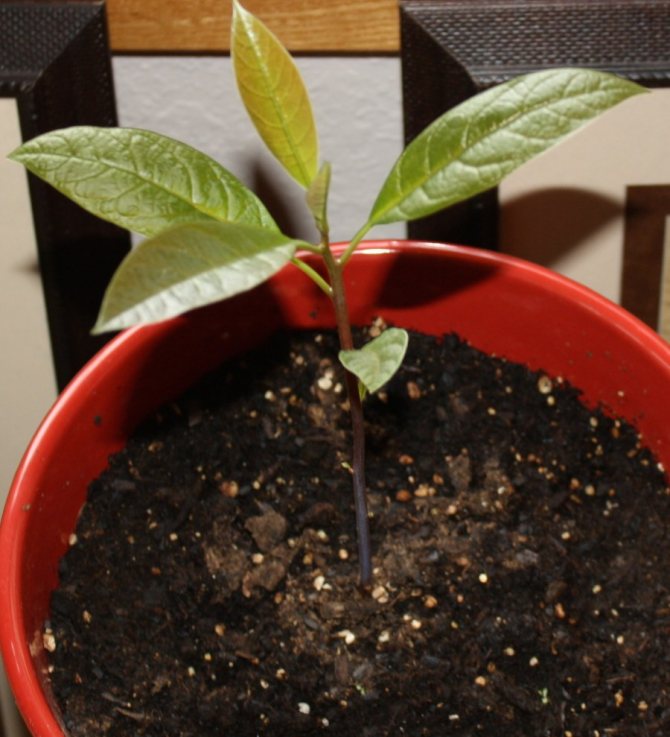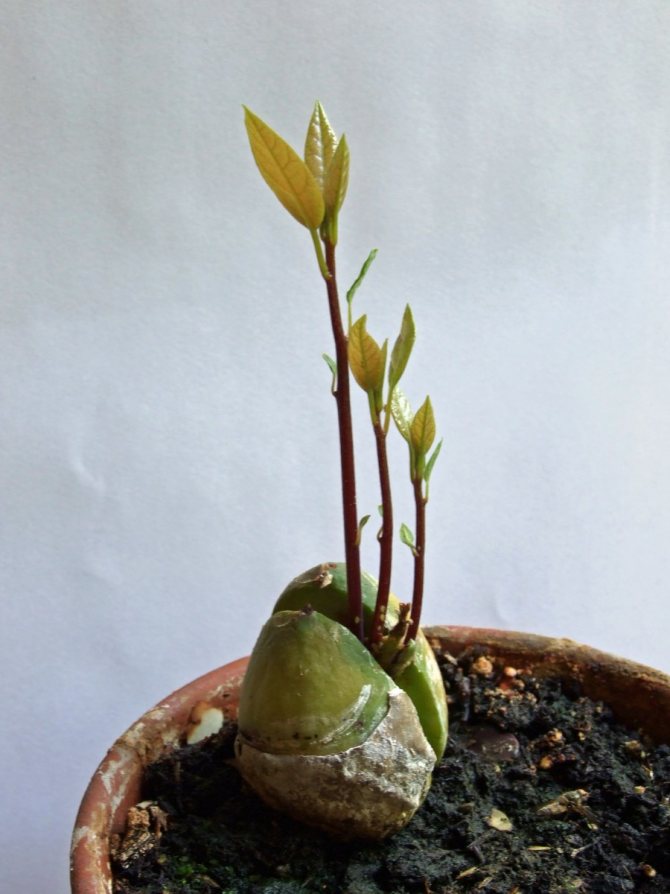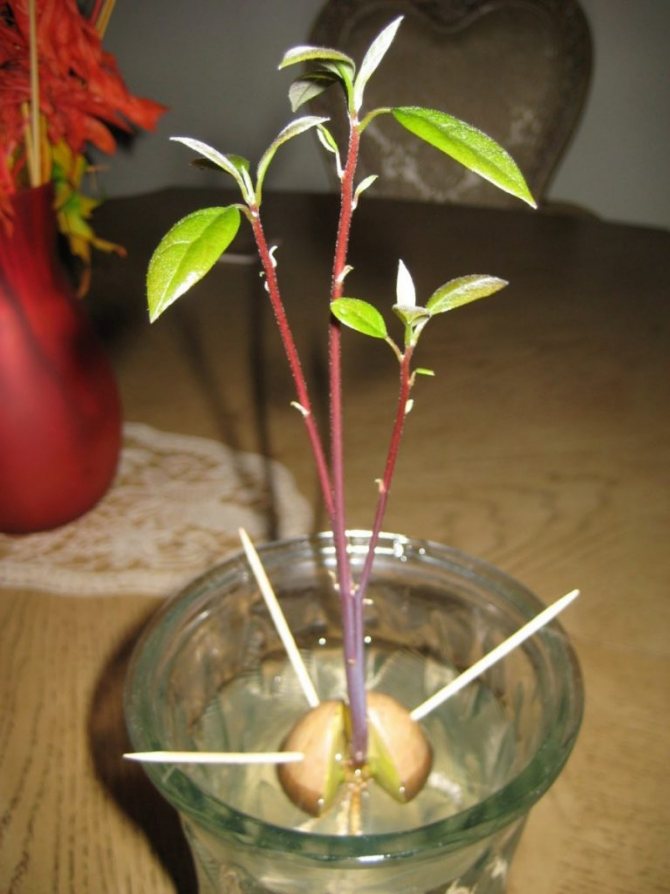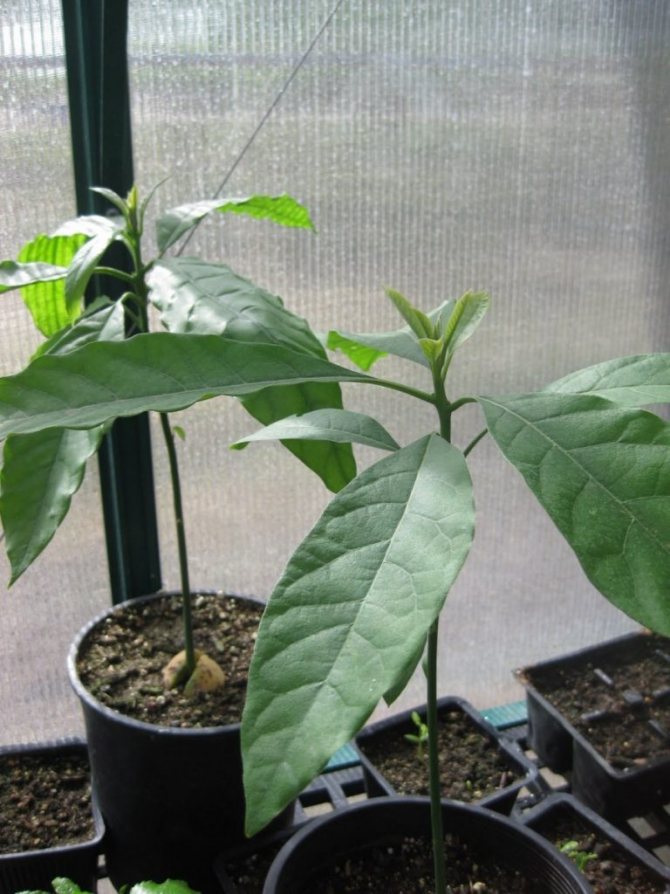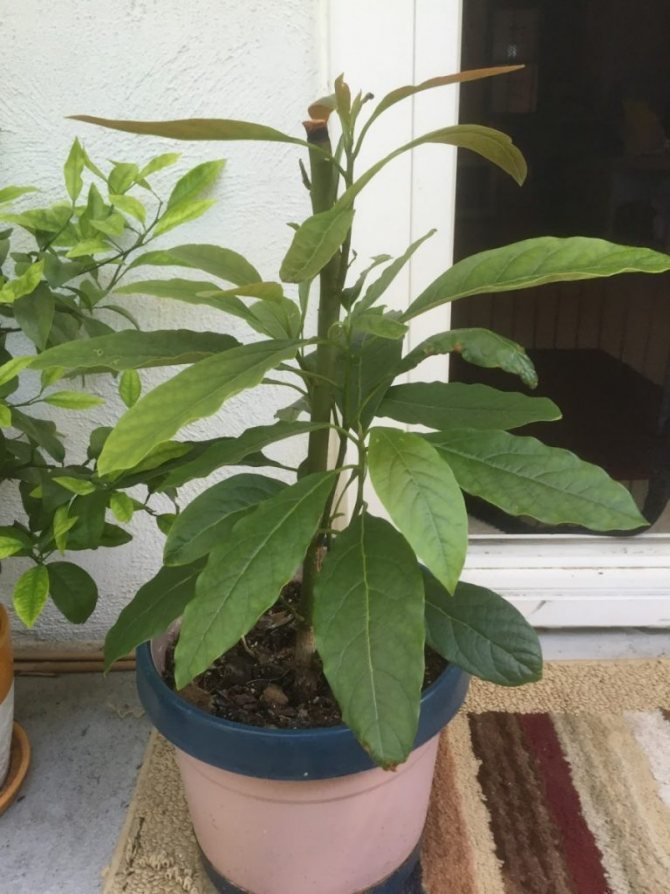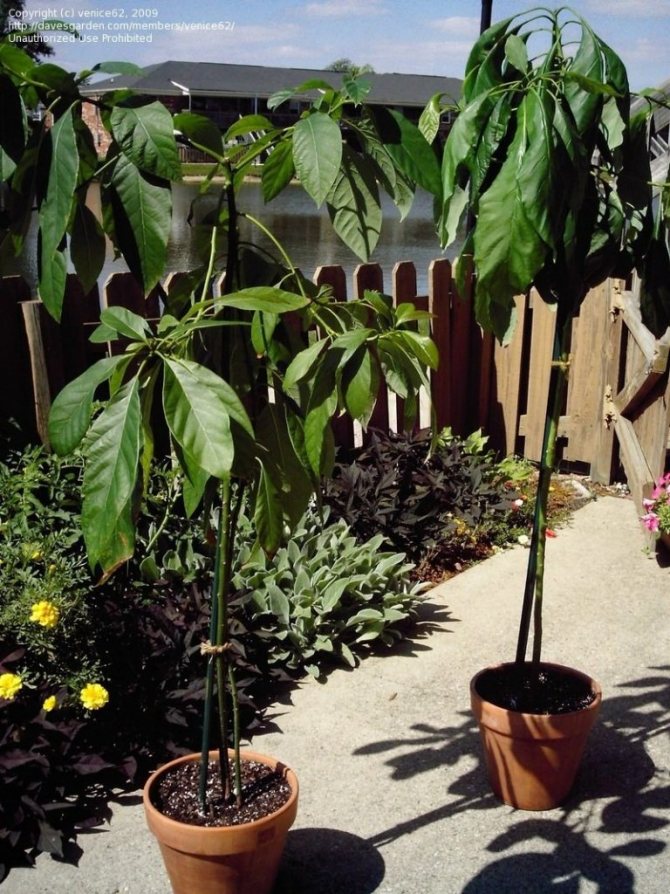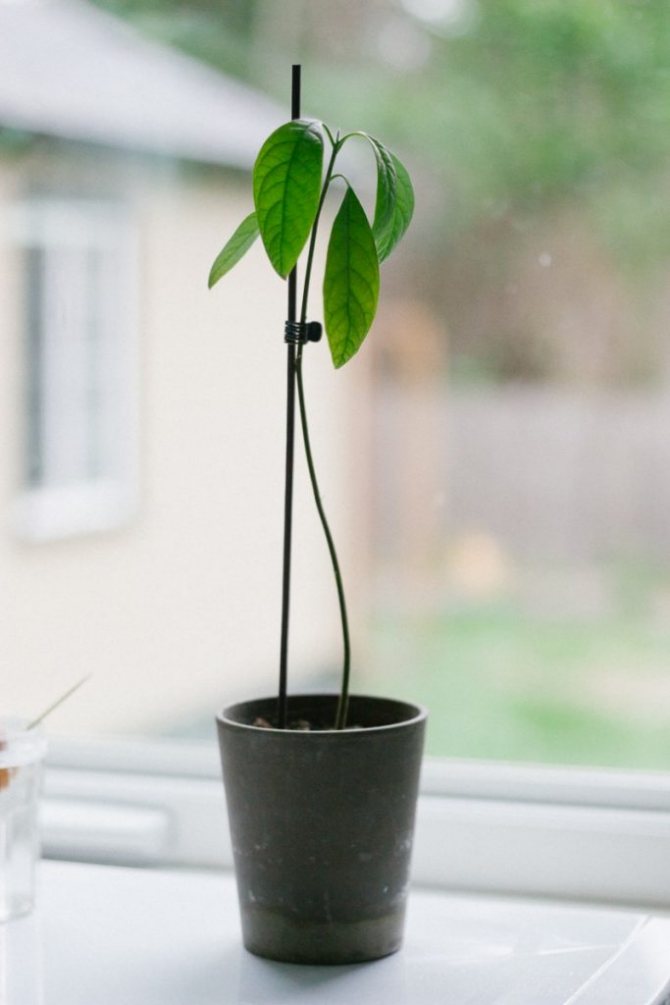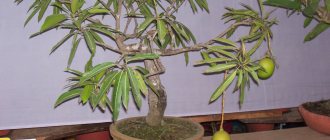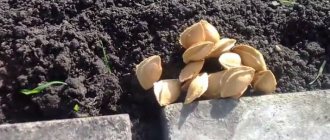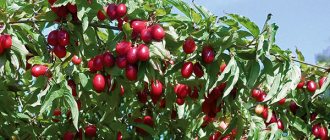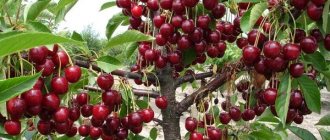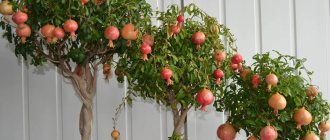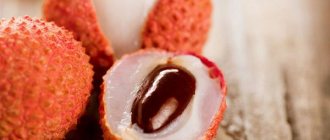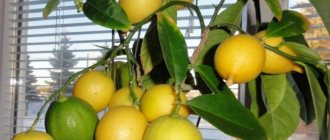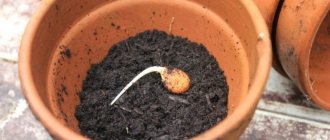Recently, flower growers have shown interest in exotic crops grown at home. Lovers are ready to boast of fruit-bearing trees, decorative weaving and beautiful flowering. Growing an avocado from a stone at home has a number of features:
- the length of the tree reaches 2.5-3 m (in the natural environment, the culture grows up to 20 m);
- culture purifies the air, the original and lush crown gives the room a warm and cozy atmosphere;
- the plant bears fruit quite rarely, more often it serves as a decorative element of an apartment or office.
Avocado in apartment conditions
Important! With proper care, the fruits ripen at the age of 3-6 years of the tree's life, the fruits are quite edible, but they are inferior in taste to their tropical counterparts.
What conditions are needed for growing an exotic tree
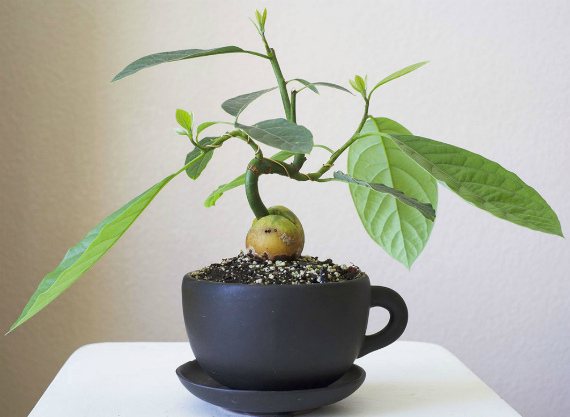
To make the avocado tree feel comfortable indoors, it is placed in a well-lit place (but not in direct sunlight!), Away from drafts. The plant does not tolerate frost at all, therefore, it is possible to take it out into the fresh air in the domestic climate only in summer.
For the full development of an alligator pear, an air temperature of +22 +27 degrees in spring and summer, and at least +18 degrees in winter is required.
Important! In natural conditions, avocados can grow up to 15-20 m in height. In a potted culture, the growth of a tree is limited to 2-2.5 m, which requires placing the plant in a room with high ceilings.
Avocado soil needs air and water permeability, with a high humus content. The soil mixture is made up of coarse sand, expanded clay, humus and garden soil, in a ratio of 1: 0.5: 1: 2. At the bottom of the planting tank, drainage from broken bricks, expanded clay, nutshells or crushed stone must be laid. Stagnant moisture in the ground leads to rotting of the avocado root system.
A correctly chosen pot is of great importance for the full development of a plant. It should be deep, since the root of the avocado is taproot, going deep into the ground. As the plant grows, it is transplanted into deeper containers.
Benefits of fruits
The composition of avocado is rich in useful elements and minerals. Depending on the type, its fruits have a different composition. Typically, avocado contains the following essential elements for the human body:
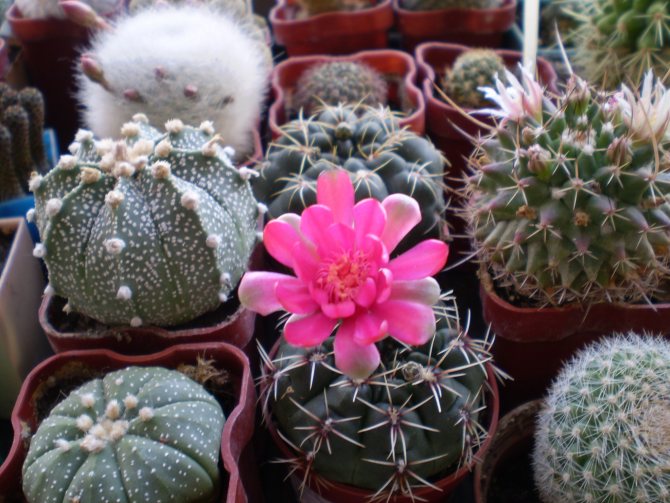

Magnesium.- Phosphorus.
- Potassium.
- Iron.
- B, E, A, PP, C.
- Calcium.
Fruits are high-calorie, but they do not contain sugar and unhealthy fats. Avocados can be safely consumed by diabetics. Doctors noted a positive effect on the health of patients. With frequent use of the fruit, recovery of strength after illnesses is noted. And also the lack of nutrients is replenished. The fruit can help solve many health problems, such as the following:
- Replenishes protein deficiencies.
- It is a natural aphrodisiac.
- Strengthening the enamel on the teeth.
- Gives strength to bones.
- Normalization of water balance in the body.
- Protection against cancer, prevents the onset of tumor diseases.
- Restoration of the gastrointestinal tract system.
- Activation of blood supply, strengthening of capillary vessels.
- Normalization of the functioning of the heart.
- Improving brain performance.
- Helps concentrate, improves memory.
- Off-season virus protection.
- Strengthening the immune system.
- Maintaining the health and youthfulness of body cells.
- Cleansing the blood from harmful cholesterol and the whole body from toxins and toxins.
Italian pinia pine, properties of pinus pinea seeds
How to grow an avocado from a seed at home
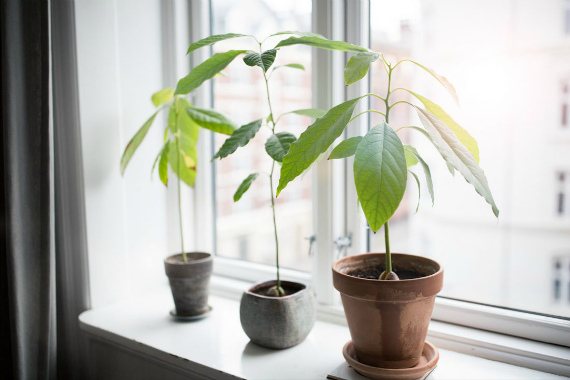

To grow a plant in an apartment, planting material can be taken from an avocado bought in a regular store.
How to choose the right fruit and extract the bone
You can get a sprout only from a bone that was extracted from a fully ripe fruit. The ripeness of the fruit is determined by touch - a ripe alligator pear is elastic. When you press your finger on the skin, the dent quickly disappears. The bone of a mature fruit is easily separated from the pulp. An unripe avocado is tough, but you can put it to ripen at room temperature with an apple next to it to speed up ripening.
On a note... The seeds from fruits with a smooth skin have better germination than from the "pimpled" avocado.
To separate the seed from the pulp of the fruit, you will need a not sharp knife and a spoon. The fruit is pierced with a knife until the moment it rests against the bone and, leading the knife around the seed, cut the avocado in a circle into two halves. The stone remains in one of the halves of the fruit. It is extracted from the pulp with a spoon. The seed is planted on the day of extraction from the fetus.
The best time to plant an avocado
Drupes planted in spring (March to June) will sprout within 15-20 days. An avocado planted at a different time can wake up for up to 2 months. It is not recommended to start sowing in winter.
Seed germination methods (closed and open version)
You can get a sprout from an avocado seed in the traditional way (closed), by planting the seed in the ground, and open, sprouting a drupe without soil. Both options have their strengths and weaknesses.
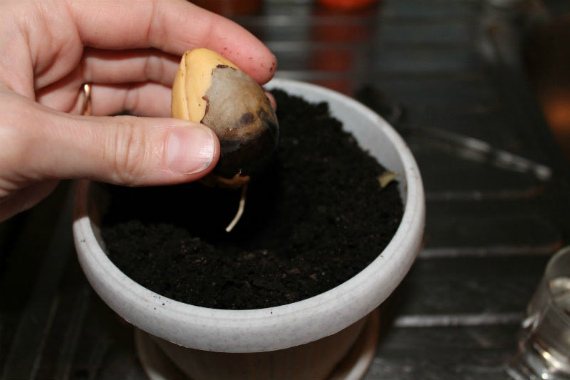

- Germinating avocados in the ground is not difficult. The drupe extracted from the fruit is immersed in loose and moist soil, with the pointed tip up. The seed does not need to be covered with soil, the top of the seed should be halfway out of the substrate.
In this position, the alligator pear is left until the sprout appears, removing the pot to a warm place. A transparent cap from a cut plastic bottle or bag is put on top of the pot. The greenhouse will accelerate the germination of the plant due to the higher temperature inside and higher humidity. It is enough to moisten the soil in the pot once every 7-10 days.
The disadvantage of this option for planting an avocado is the long wait for germination and the inability to observe the appearance of roots in the plant.
- With the "open" method of avocado germination, the seed is placed in a glass with settled water, with the blunt end down. The "butt" of the bone should be immersed in water by a third, no more. To keep the drupe in this position, toothpicks are stuck into it from different sides or the seed is fixed with a soft wire.
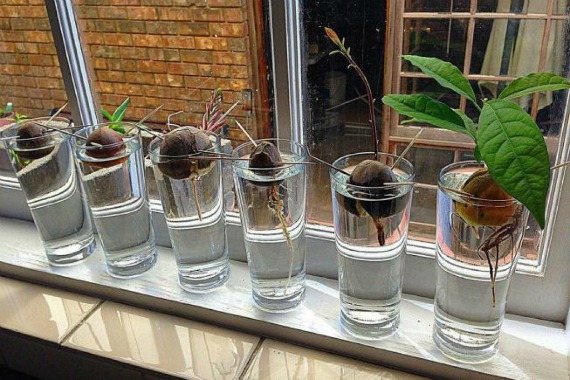

Water for sprouting avocados is taken boiled, at room temperature. Sometimes flower growers use thawed or rain moisture, add growth stimulants to it (Epin, Heteroauxin, Kornevin).
A glass with a bone is left in a bright and warm room, without drafts. You can expect the appearance of a sprout and root within a month. When the root of the avocado is 2 to 3 cm long, the plant can be transplanted into a pot.
Both options for sprouting the seed of a tropical plant are actively used by amateur flower growers.
When to expect the first sprout
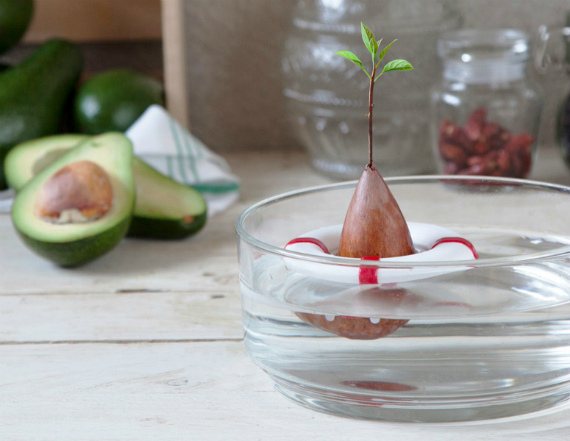

The germination energy of an avocado depends on several factors:
- season of the year;
- the size of the bone;
- the degree of maturity of the fetus;
- room temperature.
The fastest way to get a sprout is when planting a large seed of a plant in the spring. At a temperature of +25 degrees, the sprout will appear in 15-20 days. The longest (about 2 months) sprout are medium-sized drupes planted in summer and autumn.
Young plant care
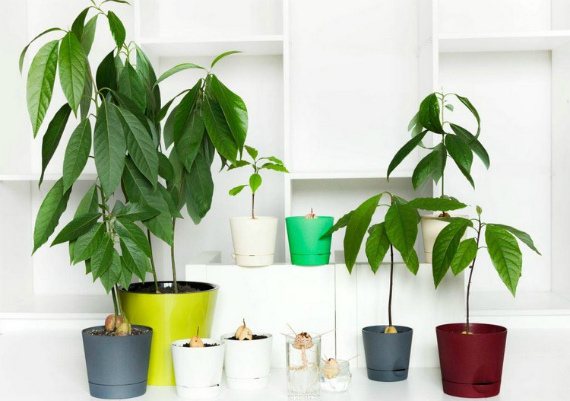

The heat-loving plant needs to be provided with a place in the light (but not in direct sunlight), warm and full.
Where to place the avocado
The pot with the plant is installed on the eastern windowsill or in the greenhouse, where the air temperature does not drop below +15 degrees. The optimum temperature for a plant during the active growing season (spring - summer) is +24 +28 degrees. In autumn and winter, it is useful to keep the plant cool by lowering the temperature to +19 degrees.
Important! The lower the air temperature, the less often the avocado is watered. Abundant watering in winter, in the "cool" period of keeping the plant, leads to decay of the roots.
Avocados need good lighting, but will burn their foliage when exposed to direct sunlight. Young specimens with delicate foliage are especially sensitive to the sun. If the plant cannot be placed in diffused light, it is protected from the bright sun with white non-woven fabric or tulle.
In summer, avocados can be taken out into the garden or on the balcony, exposing the plant in lacy shade.
Watering mode
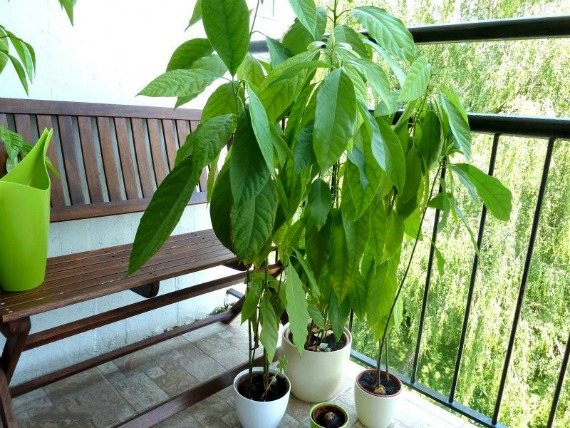

Avocado is hygrophilous, but does not tolerate moisture stagnation in the root zone. The plant is watered 1-2 times a week in the summer and not more than 2 times a month in the cold season. The water is used soft and not cold.
Advice. Avocados need watering if the potted substrate is dry to a depth of 3-4 cm.
In summer, in the heat, it is necessary to increase the air humidity to 75-80%, avoiding moisture getting on the leaves. That is, it is not recommended to spray the plant. Air humidity is increased with a household humidifier or by placing bowls of water near the plant.
Top dressing
Avocados are fed once a month from April to October. Use a complex mineral fertilizer for indoor flowers or citrus fruits. The nutrient solution is added to the soil after abundant watering with plain water.
Ready-made fertilizer mixtures can be alternated with watering the plant with a weak solution of chicken manure (10 g per 1.5 l of water).
Pinching and plant formation
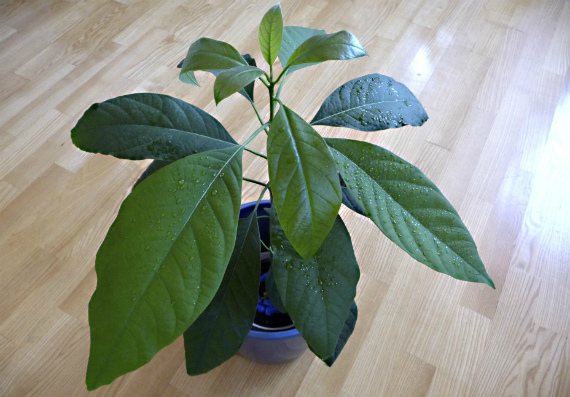

To have at home not a lanky single-stemmed tree, but a lush bush, the avocado must be shaped. To do this, pinch the top of the plant when the sprout reaches a height of 25-30 cm and has at least 8 leaves. Pinching stimulates lateral dormant buds to grow, from which lateral shoots are formed. They, in turn, can also be shortened, forming a compact and lush crown.
Advice. Do not get carried away with pinching and strive for excessive thickening of the avocado crown. All shoots and leaves should be evenly illuminated, and the crown should be well ventilated.
Some growers plant 3 sprouted drupes of avocado in one large pot at once. When the shoots rise to a height of 20 cm, they begin to weave together. The weave is made loose so that the plants do not strangle each other. As a result, after a few years, a lush avocado bush is formed, with an original trunk design.
Transfer
Until the age of 4 years, avocados are transplanted annually, after 4 years - every 3 years. For the next transplant, a pot is selected to the plant, 7-9 cm deeper than the previous one. The container must have drainage holes in the bottom. At the bottom of the vessel, at least 3 cm of pebbles or expanded clay are poured.
The avocado is transferred to a new container, using the transshipment method, being careful not to disturb the roots. It is not necessary to deepen the stem.
Prevention of diseases and pests
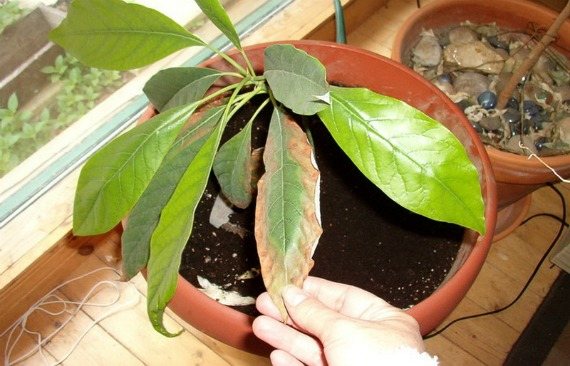

If the rules of cultivation are violated, avocados can suffer from late blight, powdery mildew. Diseases develop in conditions of high humidity and low air temperatures. You can cure a houseplant in the early stages of the development of the disease by spraying with copper-containing preparations: HOM, Topaz, Bordeaux mixture.
As a prophylaxis of diseases, the rules of agricultural technology are observed:
- water the avocado only with warm water, avoiding waterlogging;
- the soil substrate is steamed or spilled with potassium permanganate or Fitosporin before planting;
- contain plants at a temperature not lower than + 15 degrees.
At home, avocados can suffer from harmful insects: scale insects, spider mites, aphids. Insects can be seen on the foliage and stem of the plant with a magnifying glass. Get rid of them by washing the aboveground part of the avocado with soapy water and changing the topsoil in the pot. In case of severe damage to the plant by pests, use the preparations Fitoverm, Actellik.
Answers to frequently asked questions
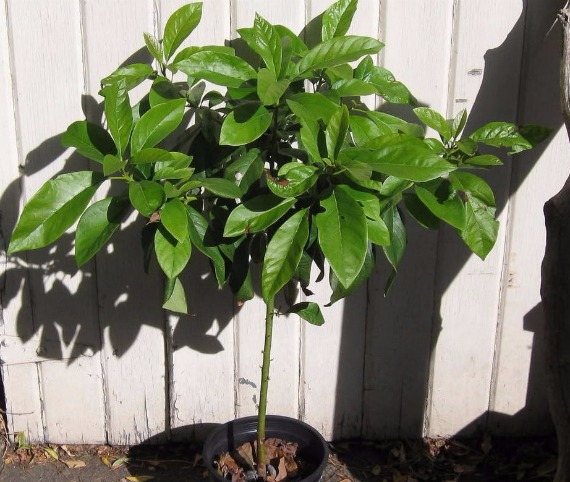

Indoor avocado is a rare plant for flower growers, and they have a lot of questions regarding this exotic plant.
Will avocado bear fruit at home
Subject to the rules of cultivation, avocados can bloom for 3-4 years of life. Flowers bloom in small umbellate inflorescences. They are small, white-greenish, like stars. But in order for the fruit to set on the tree, it is necessary to put 2 plants next to it in order to get cross-pollination.
It is very difficult to achieve flowering and fruiting of an avocado in an ordinary apartment. In the form of a lush green bush, the alligator pear is no less decorative.
If a tree has dropped its foliage, does this mean that it has died?
Avocados can shed their foliage if the room temperature drops below +12 degrees. Leaves can dry out and fall off at low humidity and lack of watering.
You can save a tree without foliage if its trunk is alive. The plant is transferred to heat, high humidity is provided. Soon, the foliage on the plant will grow back.
Is an avocado a fruit, vegetable, or berry?
From a biological point of view, avocado is a fruit, as it grows on a tree and belongs to fruit plants. More precisely, it is a drupe, like apricot and peach.
In cooking, the avocado fruit is used more as a vegetable, since it does not have a sweet taste and has a high nutritional value. It is used as an ingredient in salads, as a filling for sandwiches, and in soups made from avocado.
Appearance
What does an avocado tree look like? The plant is an evergreen tree that can reach a height of 6-18 m. The tree has ovoid leaves with pointed tips about 10-20 cm long and 2-12 cm wide in a dark green hue. The flowers of the plant are unsightly, yellow-green in color, collected in small inflorescences in the form of umbrellas.
The avocado fruit is a green drupe with a dense dark green skin. Its pulp is also green in color, has a slightly sweetish taste and creamy-buttery consistency. The size of avocado fruits varies from 5 to 15 cm, depending on the degree of ripeness and variety.
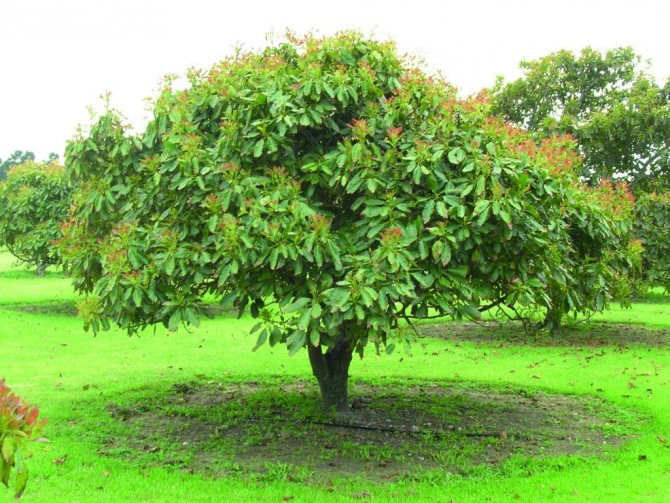

The avocado tree comes in three varieties:
- West Indian - Suitable for growing in tropical climates with high humidity.
- Guatemalan is a hardy species that grows in the subtropical highlands.
- The Mexican is the most common variety due to its resistance to mild low temperatures, which other varieties cannot boast.
Due to the different varieties of culture, avocados from different countries may have slightly different appearance and taste from each other.

